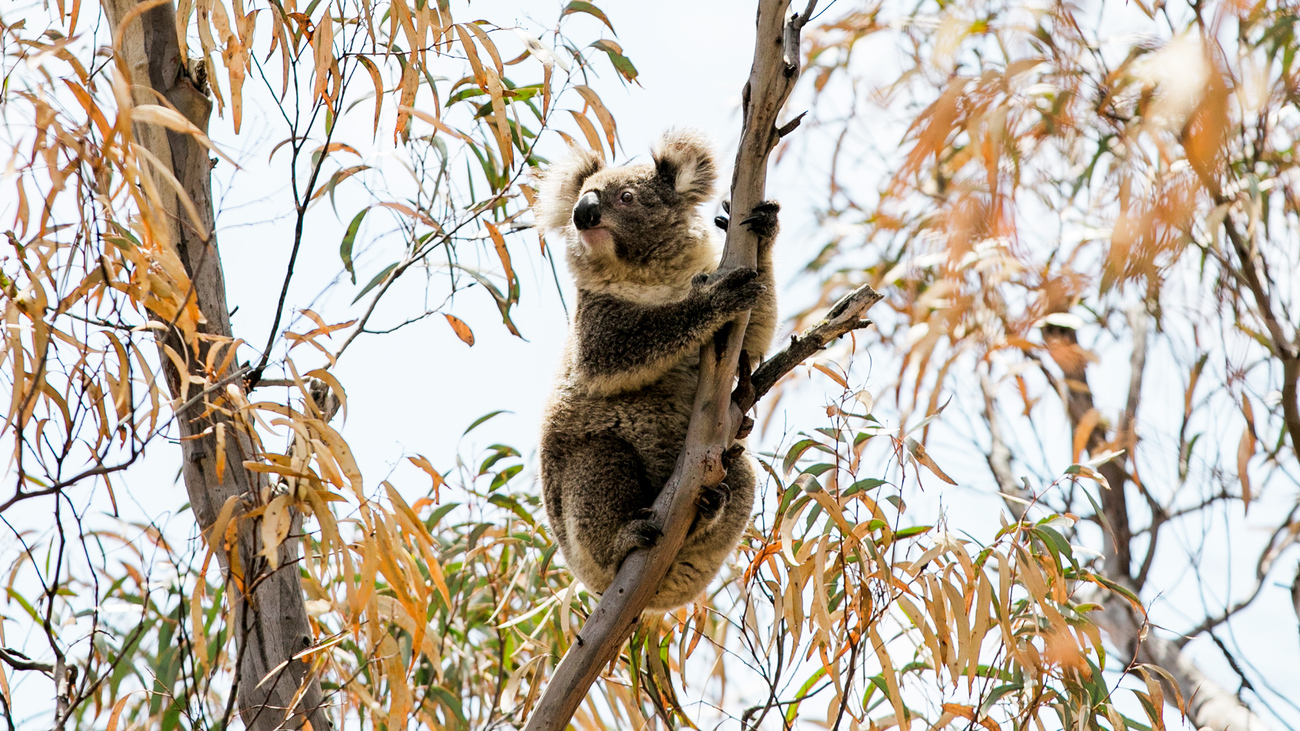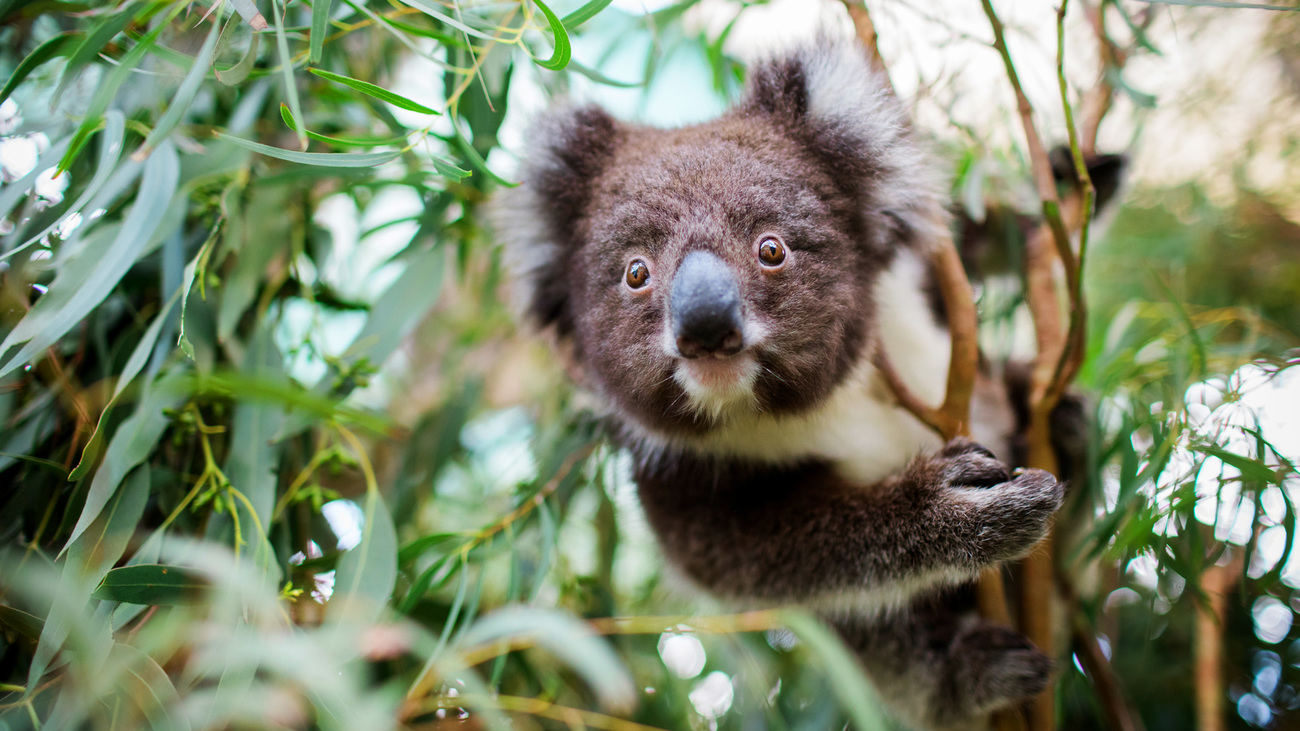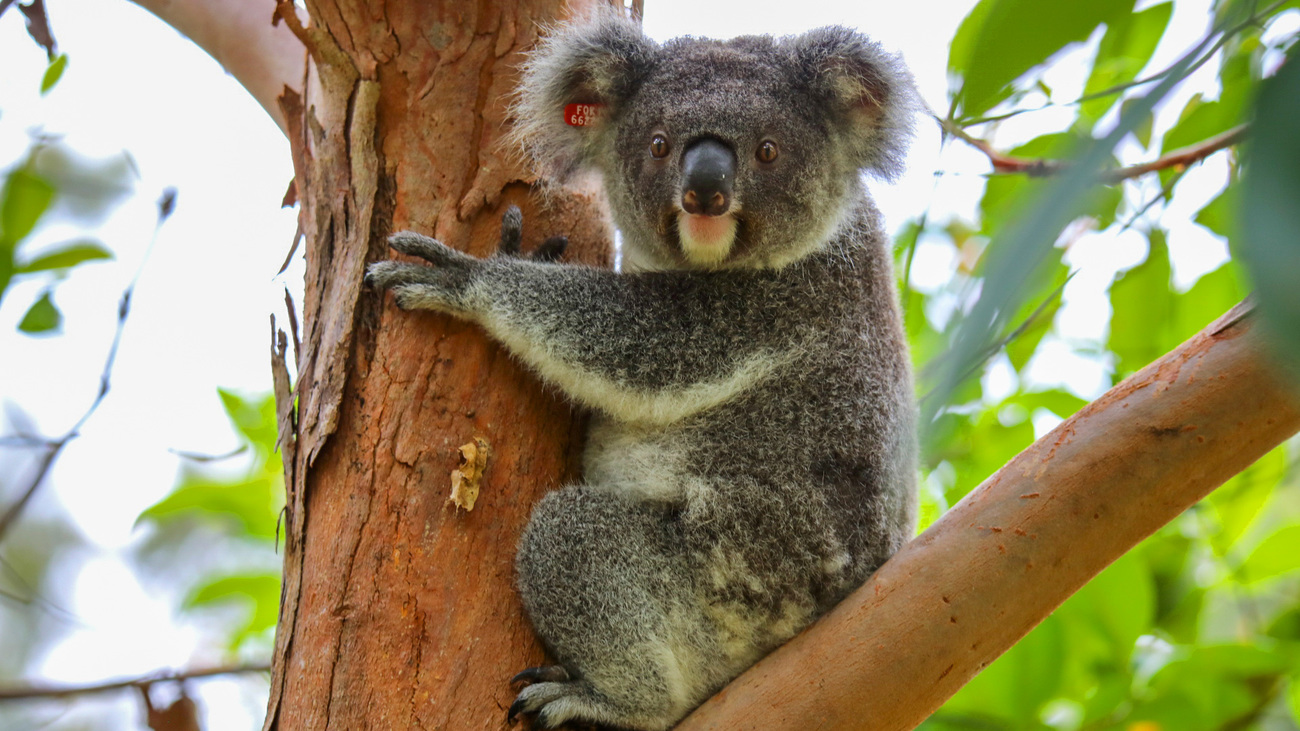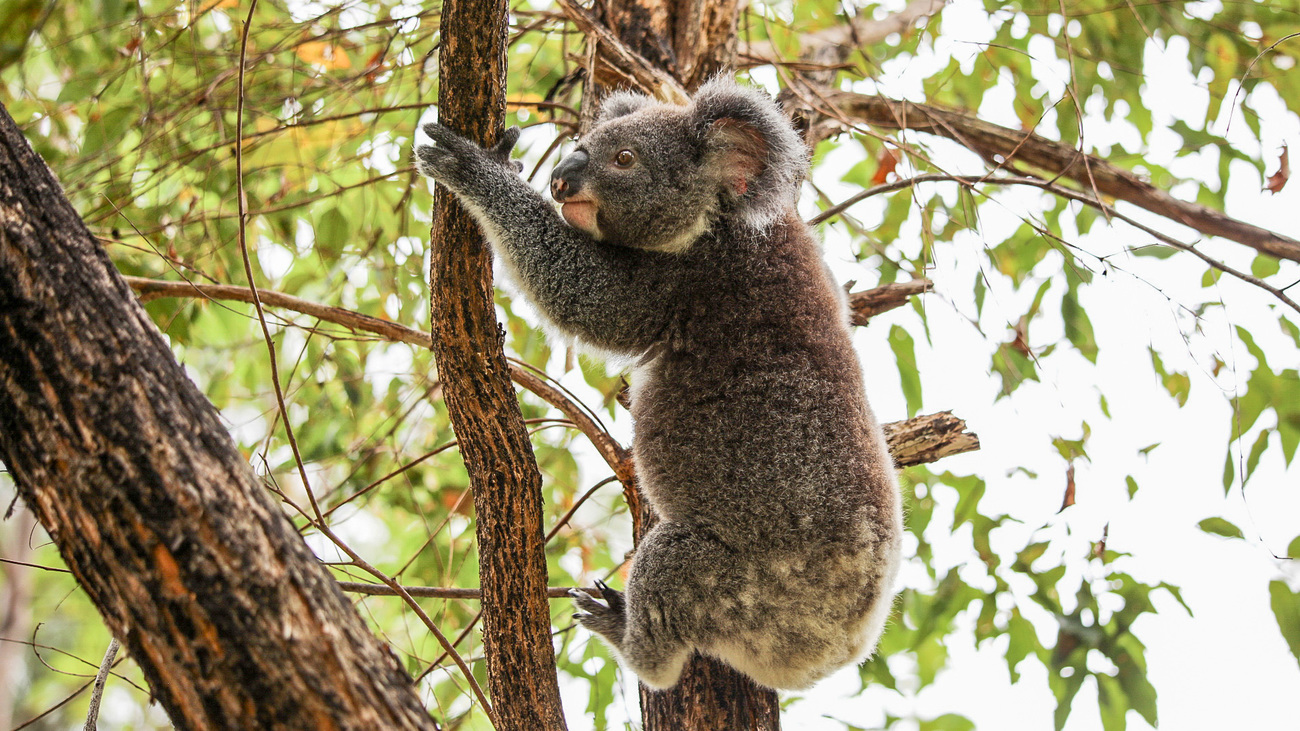Koalas
What is a koala?
Koalas are one of the most widely recognized animals in Australia. Thanks to their cuddly appearance, they’re often referred to as koala bears, though they are not members of the bear family. Koalas are medium-sized marsupials, but their round faces, rounded leathery noses, prominent eyes, big, fluffy ears, and soft, thick coats of fur all contribute to their teddy bear-like appearance.
Koalas have short tails, stout bodies, and strong, clawed feet. Their front and hind feet have opposable digits adapted to help them grip and climb trees. While koalas are typically depicted as having silver-grey fur, they can also be chocolate-brown, depending on their geographical location.
Koalas are primarily found in coastal eastern and southeastern Australia. In the southern part of their range—Victoria and South Australia—koalas can weigh up to 14 kilograms, reaching lengths of up to 85 centimeters. Further north in Queensland, koalas only reach about half that size.
They have a highly selective diet—koalas mainly feed on eucalyptus tree leaves, which provide them with both nutrition and water. These herbivores have a specialized digestive system that allows them to detoxify the chemicals in eucalyptus leaves, which can be toxic to many other animals. Their cecum, an intestinal pouch around two meters long, is crucial for breaking down the leaves’ tough cellulose and toxic chemicals. Despite eating up to 1.3 kilograms of these leaves daily, they provide little nutritional value, leaving the koalas with little energy to expend. As a result, koalas are very sedentary, sleeping for an average of 18 to 20 hours per day. As nocturnal creatures, most of their waking hours are at night. Though they’re generally calm and quiet, when they do communicate, koalas emit loud, hollow grunts.
Koalas are generally solitary animals and tend to stick to a distinct home range. The size of these home ranges can vary depending on the quality of the habitat and the koala’s sex, age, and social position. On average, a koala’s home range includes around a dozen trees, and they favor one tree in particular. Unless they’re breeding, koalas tend not to visit each other’s home range of trees.
Younger breeding females tend to give birth to one baby koala—known as a joey—per year. As they get older, female koalas tend to give birth to a joey every two or three years. A single joey is born after a gestation period of around 34 to 36 days. They’re usually only two centimeters long, blind, deaf, and furless. Using instinct, smell and touch, this underdeveloped joey makes its way to its mother’s pouch. As the only member of the Phascolarctidae family, koalas have rear-facing pouches. Once in the pouch, it latches onto a teat and feeds on the mother’s milk. After around five months, the joey will emerge from the pouch for the first time. For the following six weeks, the joey is weaned on pap, a pre-digested eucalyptus substance that is consumed directly from the mother’s anus.
After the weaning period, the joey lives on its mother’s back until it’s about one year old. The female koala reaches full maturity at age two, while males mature at three or four years old. Once mature, they find their own home ranges. Koalas live for up to 15 years in the wild.
Koalas help influence the growth and health of their eucalyptus forest habitats. Through their selective feeding habits, koalas shape the composition of the forest’s vegetation, promoting the growth of certain eucalyptus species over others. This has a knock-on effect on the entire ecosystem, influencing the abundance and diversity of other plant and animal species. Plus, by consuming eucalyptus leaves, koalas help control the dried leaf debris on the forest floor, lowering the likelihood of intense fires that can devastate ecosystems.
Eucalyptus trees are efficient carbon dioxide absorbers, so by maintaining the health of eucalyptus forests, koalas indirectly contribute to carbon sequestration, which helps mitigate global warming and climate change.
What is a koala’s scientific name?
The koala’s scientific name is Phascolarctos cinereus. Phascolarctos comes from the Greek words phaskolos, meaning ‘pouched’, and arktos, meaning ‘bear’. Cinerus is a term of Latin origin that describes ashy grey.
Their common name, koala, is thought to come from the Dharug people, from a term meaning ‘no water’. This is likely because koalas are rarely seen drinking water, as they get most of their hydration from eucalyptus leaves. They are only known to drink water during drought or when eucalyptus is unavailable, such as after a wildfire.
Although they are commonly called koala bears, koalas are not bears. They are marsupials and the only member of the Phascolarctidae family. When Europeans settled in Australia, they mistakenly called them bears due to their physical resemblance to bears.
Are koalas endangered?
The IUCN Red List classifies it as a vulnerable species, only one classification above endangered.
However, as of February 2022, the Australian government has listed the koala as endangered.
Unfortunately, their population is decreasing.
Where do koalas live?
Koalas are found exclusively in Australia’s tall eucalyptus forests and low eucalyptus woodlands. They’re found more specifically in eastern and southeastern Australia, in Victoria, South Australia, Queensland, and New South Wales.
Threats
Koalas face an array of threats that jeopardize their survival in the wild. From habitat loss and climate change to hunting and disease, these once-abundant marsupials are now confronting challenges that demand our urgent attention and conservation efforts.

Habitat loss
One of the main threats to the survival of koalas is the loss of their natural habitat. Human activities, including land clearing, urbanization, and logging, have destroyed vast tracts of eucalyptus forests where koalas are found. As human settlements expand and industries encroach further upon koala habitats, these marsupials find themselves with a smaller range and fewer food sources.
As a result of habitat loss, koala populations are forced into more fragmented areas. Fragmentation not only reduces the available eucalyptus trees but also isolates populations, hindering genetic diversity and increasing the vulnerability of koalas to other threats.
Hunting
Koalas have historically been hunted for their fur. Between 1888 and 1927, it’s estimated that at least eight million koalas were killed specifically for the global fur trade.
Their fur is well adapted to protect them from the elements while they sleep in the trees. Their waterproof, durable coats were desirable for making hats, gloves, and coat linings.
While hunting koalas is no longer a widespread practice, some human- and pet-caused koala deaths still occur. The Australian Koala Foundation reports that due to a loss of habitat and the proximity of human populations to the koala’s natural habitat, approximately 4,000 koalas are killed each year by vehicle collisions and dogs.
Climate change
Koalas are one of the 10 animals most vulnerable to climate change, according to the IUCN Red List. As CO2 levels in the atmosphere increase, the nutritional quality of eucalyptus leaves decreases. Since eucalyptus is their sole food source, this leaves koalas at severe risk of malnutrition and starvation.
Climate change is also leading to much hotter and drier weather. As a result, eucalyptus leaves are drying up and failing to hydrate koalas. This has led to koalas leaving the safety of their eucalyptus trees to seek other water sources. Heat waves can be fatal for koalas and many other species. The expected increase in the frequency of heat waves in Australia, thanks to climate change, makes it much more difficult to maintain koala populations.
Beyond a lack of food sources and available water, changing weather patterns and drier habitats can also lead to a higher incidence of wild bushfires. This puts koalas at risk of death from the bushfires themselves, and if they do survive, it further shrinks the size of their habitat.
Disease
It is quite commonly known that koalas are affected by chlamydia. Chlamydia is a sexually transmitted bacterial infection that can cause blindness and infertility in koalas, among other serious health issues. Sometimes, contracting chlamydia can be fatal for koalas. The prevalence of chlamydia among koala populations is exacerbated by stressors such as habitat loss and climate change, making koalas more susceptible to infections.
FAQs
What do koalas eat?
Koalas eat eucalyptus leaves, which provide their primary source of nutrition and water. They’re known to consume the leaves of several eucalyptus species, but they can be particularly selective in their choices, preferring certain types.
How much does a koala eat per day?
Koalas graze on eucalyptus throughout the day and night, consuming a total of 1.3 kilograms of leaves each day.
How many koalas are left in the world?
Estimates vary, but it’s thought that there are between 100,000 and 500,000 koalas remaining in the wild.

Are koalas only in Australia?
Koalas are native to Australia and are only found in the wild in Australia’s eucalyptus forests and woodlands.
How long do koalas sleep?
Koalas can sleep for up to 20 hours per day. They’re nocturnal animals, meaning they’re most active at night and around dawn and dusk.
Could koalas go extinct?
Koalas are expected to go extinct in New South Wales, Australia, by 2050. With vulnerable and decreasing populations, the species could certainly go extinct without extensive conservation efforts.
If they were to go extinct, the health of eucalyptus forests would suffer. Koalas look after their habitat’s ecosystem by controlling plant growth, enriching the soil with their scat, and reducing the amount of eucalyptus leaves that could fuel wildfires.
Are koalas endangered?
The IUCN Red List classifies koalas as vulnerable. However, the combined population of koalas in Queensland, New South Wales, and the Australian Capital Territory was listed as endangered by the Australian government in February 2022.

What are baby koalas called?
Baby koalas are called joeys.
How long do koalas live?
In the wild, koalas can live for an average of 15 years. Female koalas have been known to live slightly longer than males, reaching 18 years old.
Our work
IFAW is actively engaged in efforts to conserve and protect koalas and the trees they call home.
Throughout Australia’s east coast, we rescue, rehabilitate, and release koalas, with our projects involving community engagement, landscape conservation, and policy work to ensure koalas’ long-term welfare and conservation.
This includes collaboration with various partner organizations, including Friends of the Koala and Mosswood Wildlife to help treat hundreds of koalas each year, as well as Koala Clancy Foundation and Bangalow Koalas to restore wildlife corridors for koalas and other animals and the University of the Sunshine Coast’s Detection Dogs for Conservation to find and rescue sick or injured koalas and carry out koala health and habitat surveys.

The IFAW team helps seek out sick koalas infected by potentially fatal diseases like chlamydia to treat them and get them back to full health. They’re also on the ground with our partners to rescue and rehabilitate koalas impacted by bushfires. This is especially important as koalas are particularly susceptible to bushfires, which are increasing in frequency and intensity due to climate change.
One of the main threats to koalas is habitat loss and fragmentation. Our work involves planting trees to help restore their habitat, reconnecting fragmented populations, and providing access to more food sources. Key to this work is addressing the root cause of habitat loss and advocating for better protections for koalas and the places they call home. This included IFAW taking the lead to call for koalas on the east coast to be up-listed to endangered after the catastrophic 2019-20 bushfires devastated already dwindling populations.
We work with all levels of government to protect koala habitat from development and land clearing and encourage the implementation of stronger legislation to ensure koalas thrive into the future.
How can you help?
Koalas are a vulnerable species that need our help in protecting them against the threats of habitat loss, climate change, and disease. IFAW is working tirelessly to conserve their decreasing populations.
